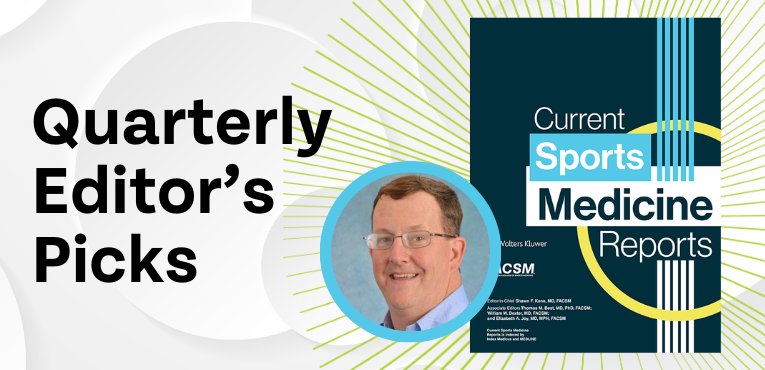|
Jan.
23, 2025
 I hope everyone’s 2025 is off to a good start and welcome to the highlights and review of the AMAZING material published over the last quarter in Current Sports Medicine Reports (CSMR).
I hope everyone’s 2025 is off to a good start and welcome to the highlights and review of the AMAZING material published over the last quarter in Current Sports Medicine Reports (CSMR).
Invited Commentary
Integrating Fitness Equipment in Persistent Traumatic Stress Environments for Reducing Drug Overdoses authored by Eric Randall, BS. This is a great example of the impact that Exercise is Medicine® can have on a population. The author highlights a very simple intervention, installation of fitness of equipment, that demonstrated positive results. There are numerous and well documented reasons why having access to fitness equipment is beneficial and this is another one. It shows that when people who are struggling are afforded an opportunity, they now have a choice to help make things better and possibly prevent a tragedy.
Case Reports
Case reports are a great way to learn whether the write-up is about some rare, uncommon condition or just a different presentation of a common problem. I would like to highlight two not-to-be-missed cases from the past quarter:
Case Study: Nutrition Planning Intake during Norseman Extreme Triathlon in a Recreational Athlete Nutrition Intake for Extreme Triathlon authored by Selin Aktitz, MSc. So I am of the belief that doing any triathlon is crazy, but a Norseman Extreme Triathlon takes it to an entirely new level – an ironman distance triathlon in cold, rugged Norway; and congrats you get a black t-shirt if you finish in the top 160. The nutritional component to an extreme race plan is vital for optimizing success. This case report thoroughly details the nutritional needs of this athlete to optimize performance throughout the entire race. If you are planning to compete in an extreme race this is a great blueprint on how to do it.
Dysuria in the Collegiate Athlete authored by Tatum Khouri, MD and Robert Kiningham, MD, FACSM. This is a great case study because it emphasizes an important concept, master the basics. Urinary track infections (UTIs) in women are common, easy to treat and many times we don’t give them a second thought, but should we? One comment included in the case report was, is it was great to see antibiotics not prescribed based on the testing. It seems like most of the time antibiotics are given without or regardless of the testing. Recurrence of symptoms led to more investigation and the likely etiology was found, treated and the condition resolved. Pelvic myofascial pain, while not the main topic of the article is mentioned in the differential and is something to keep in mind when treating female athletes with pelvic pain.
We also have some awesome articles that cover a variety of areas, and I would like to highlight three from the past quarter:
Seems like we had a little bit of a rock-climbing theme last quarter.
More Than Just Another Elbow Tendinopathy: A Cases Series of Misdiagnosed Ulnar Nerve Compression and Review of Common Upper Extremity Misdiagnoses in Climbing authored by Leo L.T. Meller, BS; Matthew R. Allen, BS; Logan H. Sigua, BS; Jason Hooper, PT, DPT, OCS, SCS; and Kenneth Vitale, MD, FACSM. Admittedly, I do not see a lot of climbers, so these climbing articles were interesting. This article to me highlighted the concept of if your treatment is not working then you might want to revisit the diagnosis. Nerve injuries can be tough to diagnosis and treat, so maybe we avoid diagnosing them and default to what we are comfortable with. The cases and the subsequent review by these authors will help everyone expand their differential of elbow pain, not just in climbers.
Rock Climbing-Related Injuries: A Clinical and Imaging Overview authored by Paulo Miro, MD; Emily Miro, MD, MPH; Tiffany Ho, MD, MPH; Melissa Feuerborn, MD; Amanda Crawford, MD; and Volker Schöffl, MD. This outstanding article which was published the following month is an excellent and thorough review of upper extremity injuries experienced by climbers. The authors do an amazing job of using imaging modalities and figures to highlight and show the pathology. While the authors tailor the article to climbers and focus primarily on the hand and wrist, this is a great review of upper extremity pathology and worth the read.
Preparticipation and Sideline Evaluation of Athletes with Intellectual and Developmental Disability authored by Shawn Phillips, MD, MSPT; Jayme Galdieri, MS, LAT, ATC; Caitlyn Haines, MD; and Jeremy Palmer, DO. This article is an excellent review of the challenges and rewards of caring for athletes with intellectual and developmental disability. The importance of the pre-participation examination is highlighted as what to worry about in what sports is reviewed. If you are involved in these events or are considering getting involved this is a great review article.
This quarter I would like to highlight a Special Communication article published in the October edition.
Pain Medication Data from the 2021 and 2022 National Football League Prescription Drug Monitoring Program authored by Kevin P. Hill, MD, MHS; Kurt Kroenke, MD, MACP; Erin B. Wasserman, PhD; Christina Mack, PhD, MSPH; Geoffrey S.F. Ling, MD, PhD; Thom Mayer, MD; Gary Solomon, PhD; and Allen Sills, MD, FACS. I was excited to work with these authors who represented the National Football League (NFL) and the National Football League Players Association (NFLPA) and was appreciative of them choosing CSMR. Pain management is an essential element of patient care and can be incredibly challenging. The data in this paper show a high degree of transparency and a commitment to excellent patient care by the NFL and the NFLPA. In my opinion, if pain can be managed in NFL players with a low rate of opioid prescriptions, then we can manage pain with less opioids across all patients.
CSMR is ACSM’s official monthly clinical-review e-journal. Written specifically for physician and clinician members, CSMR articles provide thorough overviews of the most current sports medicine literature. ACSM physician members receive an online subscription to this journal as a member benefit.
 Shawn F. Kane, MD, FACSM is a family physician, professor in the Department of Family Medicine, and adjunct assistant professor in the Department of Exercise and Sports Science at the University of North Carolina (UNC) Chapel Hill. He received his medical degree from the Uniformed Services University of the Health Sciences and served in the U.S. Army for 27 years. He is interested in sports medicine, concussion care, veterans’ health, and primary care of patients with post-traumatic stress disorder. Dr. Kane joined ACSM in 2003 and became a fellow in 2011. He currently serves as the editor-in-chief for Current Sports Medicine Reports, on ACSM’s Clinical Sports Medicine Leadership Committee, ACSM’s Health & Fitness Summit Program Committee, and ACSM’s Program Committee. Outside of the office, Dr. Kane enjoys hanging out with his Leonbergers (big, furry, cute German Mountain dogs), as well as working out and traveling.
Shawn F. Kane, MD, FACSM is a family physician, professor in the Department of Family Medicine, and adjunct assistant professor in the Department of Exercise and Sports Science at the University of North Carolina (UNC) Chapel Hill. He received his medical degree from the Uniformed Services University of the Health Sciences and served in the U.S. Army for 27 years. He is interested in sports medicine, concussion care, veterans’ health, and primary care of patients with post-traumatic stress disorder. Dr. Kane joined ACSM in 2003 and became a fellow in 2011. He currently serves as the editor-in-chief for Current Sports Medicine Reports, on ACSM’s Clinical Sports Medicine Leadership Committee, ACSM’s Health & Fitness Summit Program Committee, and ACSM’s Program Committee. Outside of the office, Dr. Kane enjoys hanging out with his Leonbergers (big, furry, cute German Mountain dogs), as well as working out and traveling.